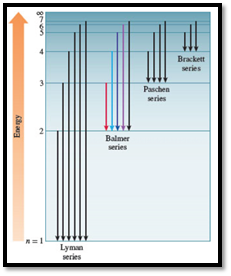
Interpretation:
The inadequacies of Bohr’s theory should be explained using the concept of Bohr’s theory.
Concept Introduction:
The emission of radiation given by an energized hydrogen atom to the electron falling from a higher-energy orbit to a lower orbit give a quantum of energy in the form of light. Based on electrostatic interaction and law of motion, Bohr derived the following equation.
where
The electrons are excited thermally when the light is used by an object. As a result, an emission spectrum comes. Line spectra consist of light only at specific, discrete wavelengths. In emission, the electron returns to a lower energy state from
This transition results in the photon’s emission with frequency
When
Bohr’s theory of the hydrogen atom describes an atom as a small, positively charged nucleus with electrons travelling around it in circular orbits. It explains the appearance of an emission spectrum because the “orbits” available for the electrons to occupy in their excited states are quantized. The resulting transition emits a specific wavelength of light because the energy of the “orbit” is quantized.

Figure.1
Visible line emission spectrum of hydrogen
The emission spectrum of hydrogen shows a wide range of wavelengths from the infrared to the ultraviolet region. The given table lists the series of transitions in the hydrogen spectrum, each with a different value of
| Series | Spectrum region | ||
| Lyman | 1 | 2, 3, 4, ... | Ultraviolet |
| Balmer | 2 | 3, 4, 5, ... | Visible and Ultraviolet |
| Paschen | 3 | 4, 5, 6, ... | Infrared |
| Brackett | 4 | 5, 6, 7, ... | Infrared |
The given figure shows transitions associated with spectral lines in each of the emission series. Each horizontal line represents one of the allowed energy levels for the electron in a hydrogen atom. The energy levels are labeled with their

Figure.2
Energy levels in the hydrogen atom and the various emission series.
Each series ends at a different value of
Want to see the full answer?
Check out a sample textbook solution
Chapter 7 Solutions
Connect 1 Semester Access Card for General Chemistry: The Essential Concepts
- Please help me Please use https://app.molview.com/ to draw this. I tried, but I couldn't figure out how to do it.arrow_forwardPropose a synthesis of 1-butanamine from the following: (a) a chloroalkane of three carbons (b) a chloroalkane of four carbonsarrow_forwardSelect the stronger base from each pair of compounds. (a) H₂CNH₂ or EtzN (b) CI or NH2 NH2 (c) .Q or EtzN (d) or (e) N or (f) H or Harrow_forward
- 4. Provide a clear arrow-pushing mechanism for each of the following reactions. Do not skip proton transfers, do not combine steps, and make sure your arrows are clear enough to be interpreted without ambiguity. a. 2. 1. LDA 3. H3O+ HOarrow_forwardb. H3C CH3 H3O+ ✓ H OHarrow_forward2. Provide reagents/conditions to accomplish the following syntheses. More than one step is required in some cases. a. CH3arrow_forward
- Identify and provide an explanation that distinguishes a qualitative and quantitative chemical analysis. Provide examples.arrow_forwardIdentify and provide an explanation of the operational principles behind a Atomic Absorption Spectrometer (AAS). List the steps involved.arrow_forwardInstructions: Complete the questions in the space provided. Show all your work 1. You are trying to determine the rate law expression for a reaction that you are completing at 25°C. You measure the initial reaction rate and the starting concentrations of the reactions for 4 trials. BrO³¯ (aq) + 5Br¯ (aq) + 6H* (aq) → 3Br₂ (l) + 3H2O (l) Initial rate Trial [BrO3] [H*] [Br] (mol/L) (mol/L) | (mol/L) (mol/L.s) 1 0.10 0.10 0.10 8.0 2 0.20 0.10 0.10 16 3 0.10 0.20 0.10 16 4 0.10 0.10 0.20 32 a. Based on the above data what is the rate law expression? b. Solve for the value of k (make sure to include proper units) 2. The proposed reaction mechanism is as follows: i. ii. BrО¸¯ (aq) + H+ (aq) → HBrO3 (aq) HBrO³ (aq) + H* (aq) → H₂BrO3* (aq) iii. H₂BrO³* (aq) + Br¯ (aq) → Br₂O₂ (aq) + H2O (l) [Fast] [Medium] [Slow] iv. Br₂O₂ (aq) + 4H*(aq) + 4Br(aq) → 3Br₂ (l) + H2O (l) [Fast] Evaluate the validity of this proposed reaction. Justify your answer.arrow_forward
 ChemistryChemistryISBN:9781305957404Author:Steven S. Zumdahl, Susan A. Zumdahl, Donald J. DeCostePublisher:Cengage Learning
ChemistryChemistryISBN:9781305957404Author:Steven S. Zumdahl, Susan A. Zumdahl, Donald J. DeCostePublisher:Cengage Learning ChemistryChemistryISBN:9781259911156Author:Raymond Chang Dr., Jason Overby ProfessorPublisher:McGraw-Hill Education
ChemistryChemistryISBN:9781259911156Author:Raymond Chang Dr., Jason Overby ProfessorPublisher:McGraw-Hill Education Principles of Instrumental AnalysisChemistryISBN:9781305577213Author:Douglas A. Skoog, F. James Holler, Stanley R. CrouchPublisher:Cengage Learning
Principles of Instrumental AnalysisChemistryISBN:9781305577213Author:Douglas A. Skoog, F. James Holler, Stanley R. CrouchPublisher:Cengage Learning Organic ChemistryChemistryISBN:9780078021558Author:Janice Gorzynski Smith Dr.Publisher:McGraw-Hill Education
Organic ChemistryChemistryISBN:9780078021558Author:Janice Gorzynski Smith Dr.Publisher:McGraw-Hill Education Chemistry: Principles and ReactionsChemistryISBN:9781305079373Author:William L. Masterton, Cecile N. HurleyPublisher:Cengage Learning
Chemistry: Principles and ReactionsChemistryISBN:9781305079373Author:William L. Masterton, Cecile N. HurleyPublisher:Cengage Learning Elementary Principles of Chemical Processes, Bind...ChemistryISBN:9781118431221Author:Richard M. Felder, Ronald W. Rousseau, Lisa G. BullardPublisher:WILEY
Elementary Principles of Chemical Processes, Bind...ChemistryISBN:9781118431221Author:Richard M. Felder, Ronald W. Rousseau, Lisa G. BullardPublisher:WILEY





